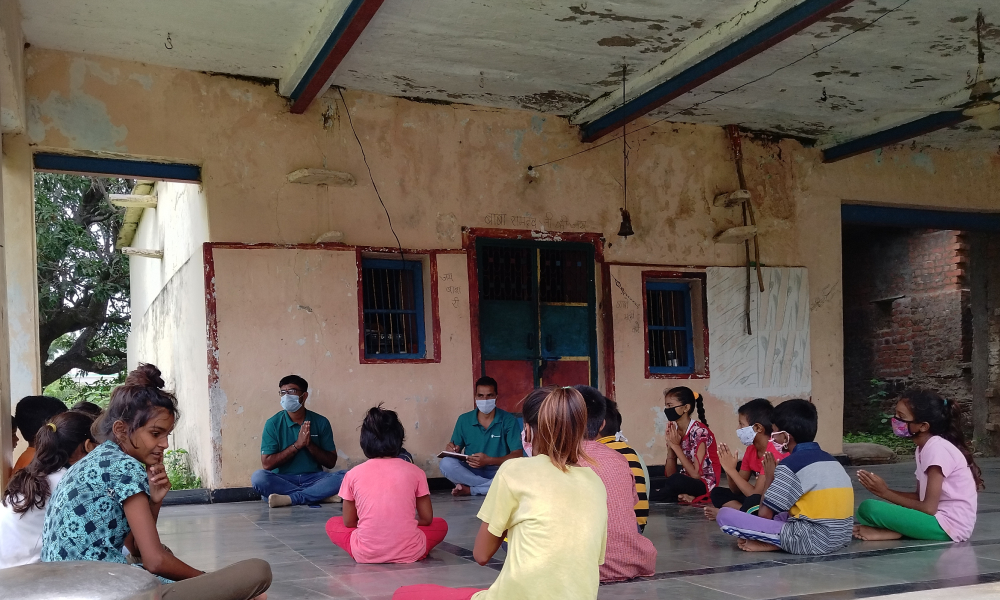
Image Credit: Save The Children
Trafficking In Persons (Prevention, Care & Rehabilitation) Bill 2021: A Boon For Child-Rights?
Writer: Shivani Bhaskar
Shivani is a child rights advocacy expert who has been associated with Save the Children for over 8 years. She has been advocating for better policies and practices to fulfil children’s rights and to ensure that children’s voices are heard at the various national and global platforms. She has been passionately working for the welfare of Children in Street Situations. She has been closely associated with the development and implementation of the NCPCR led Standard Operating Procedure for Care and Protection of Children in Street Situations. Her Advocacy efforts led to issuance of identity documents to over 200, 000 children in Street Situations.
India, 8 Aug 2021 10:38 AM GMT
Creatives : Kishan Rao A S
He believes in the philosophy of it is not a race to win but to create his own track. He has his opinions and realizes that every day is a learning.
The question is will the government remove anomalies that have creeped into the draft quickly, and will the Parliament pass the bill this time or will it have the same fate that its previous version had in 2018?
The Trafficking in Persons (Prevention, Care & Rehabilitation) Bill 2021 that is likely to be tabled in Parliament during the ongoing monsoon session has the potential to be a game-changer for women, children and other vulnerable people who are at the risk of being trafficked or have been victims of trafficking. It would be unique legislation that not only seeks to punish the offenders and provide care, protection, and rehabilitation to the victims but also provides for holistic preventive measures against trafficking.
Human Trafficking Situation - Global
The unprecedented global crisis caused by COVID 19 has gripped the attention of the masses. Against this backdrop, the menace of human trafficking continues to thrive unabated. According to the UNODC's latest report "The effects of the Covid 19 pandemic on trafficking in persons and responses to the challenges" Covid-19 has resulted in exacerbation of situations conducive for trafficking, and the menace has moved further underground. As per UNODC human trafficking and migrant smuggling are global and widespread crimes that use men, women and children for profit. The organized networks or individuals behind these lucrative crimes take advantage of people who are vulnerable, desperate or simply seeking a better life.
Human Trafficking Situation - India
The situation is no different in India, which has been a hub of human trafficking and a point of transit, destination, and source for both labour and sex trafficking. India over the last few years has witnessed an increasing trend in trafficking. According to the latest NCRB data, a total of 6,616 human trafficking cases were registered in the country in 2019, as compared to 5,788 cases in 2018 and 5,900 cases in 2017.
Children make up almost a third of all human trafficking victims worldwide, with the situation being more disturbing in India for children. According to the NCRB 2018 data, 51% of all trafficking victims were children, of which more than 80% were girls. The COVID 19 pandemic has further led to an increase in a number of children who are more susceptible to trafficking. The recently orphaned children in India, due to the Covid-19 pandemic, also run the increased risk of trafficking in the garb of adoption, employment or livelihood and shelter.
Current Legal Framework
A number of laws and provisions exist in India that cover trafficking and related crimes including Articles 23(1) of Constitution, Sections 370, 370A of Indian Penal Code 1860, The Immoral Traffic (Prevention) Act, 1956 (ITPA) (as amended in 1986), Bonded Labour System (Abolition) Act, 1976 and Child Labour (Prohibition and Regulation) Amendment Act, 2016, Juvenile Justice (Care and Protection of Children) Act, 2015, the Protection of Children from Sexual Offences Act, 2012, the Prohibition of Child Marriage Act, 2006 etc. Each of these laws operates independently, have their own enforcement machinery and prescribe penalties for offences related to trafficking.
The current legal framework on trafficking only criminalizes the act of trafficking and related offences. It addresses specific matters pertaining to bonded labour or prostitution. Though trafficking covers these issues, its scope is much wider. Presently there are no provisions in law for the prevention of trafficking, or the protection and rehabilitation of victims.
Despite the existing legal framework on trafficking, the track record of convictions in the cases of trafficking and related crimes has been dismal in India. As per a report published by Thompson Reuters Foundation in 2019, based on research by anti-slavery advocacy group Tafteesh, out of 429 people charged with involvement in 198 trafficking cases in the states of West Bengal and Andhra Pradesh from 2008 until 2018, only three convictions were made.
Need for a Comprehensive Law
India has made international commitments for tackling the issue of trafficking in a comprehensive manner. India is committed to achieving the UN Sustainable Development Goals including Goal 8.7 pertaining to eradicating forced labour, end modern slavery and human trafficking and elimination of child labour, and Goal 16.2 to end abuse, exploitation, trafficking and all forms of violence against children. India has also ratified the UN Protocol to Prevent, Suppress and Punish Trafficking in Persons, Especially Women and Children, supplementing the United Nations Convention against Transnational Organized Crime.
Trafficking in most cases is committed by organized criminal syndicates, and therefore needs to be addressed in a comprehensive manner. Hon'ble Supreme Court had also taken cognizance of the Government of India's plan to study the existing laws on the subject and to come up with comprehensive legislation in the matter of Prajwala Vs. Union of India & Ors. (2015).
Draft TIP Bill and its features
Ministry of WCD has put in the public domain the Trafficking in Persons (Prevention, Care and Rehabilitation) Bill 2021 which aims to prevent and counter-trafficking in persons, especially women and children, to provide for the care, protection, and rehabilitation to the victims while respecting their rights, and creating a supportive legal, economic and social environment for them, and also to ensure prosecution of offenders, and for matters connected therewith or incidental thereto.
This draft Bill is an improved version of the one introduced in and passed by the Lok Sabha in 2018 (but lapsed), as its scope is broader, covering even transgender and stateless people, and crimes committed outside India, and includes crimes with cross-border implications. The revised bill also has more stringent penalties and provides for NIA to be the investigation agency. The bill proposes the establishment of National, State and District Anti Human Trafficking committees for the effective implementation of the Act.
Child-friendly features
The Bill has various provisions for the benefit of children. It is broadly aligned with the JJ Act 2015. The bill has a provision under Section 8, for keeping a check, with the help of PRIs, on the children who drop out from schools and those children who are covered by various schemes and have stopped accessing the benefits of those schemes to prevent trafficking. This would also have the indirect benefit of preventing children from dropping out of schools or government welfare schemes due to constant monitoring.
The Bill protects and rehabilitates child victims of trafficking. It also provides for the development of an individual care plan for every victim to ensure their care, protection, appropriate rehabilitation and reintegration. There is also a provision of the survey of areas of vulnerable population and community mobilization which would be very useful as a preventive measure for curbing trafficking.
The Bill also envisages engaging social workers and support persons from local areas, especially for child victims. It also has proposed empowering measures including education, skilling, and livelihood programmes for vulnerable people, including children. It also provides for aadhaar enrolment of persons deemed vulnerable for their effective identification, referral and tracking. This is especially useful for children with no identity, and are vulnerable to trafficking, such as children in street situations.
Gaps in the Bill
Some anomalies have however crept into the Draft Bill. Since this is comprehensive legislation covering various aspects of trafficking, it has many provisions that some of the other existing laws already cover. There is a need to carefully balance and harmonize the bill with the existing provisions under various Acts, especially the JJ Act 2015.
For example, the Bill provides National Investigation Agency (NIA) as the lead to take up investigation in trafficking cases, there is a need to define the role of the local police, especially the Special Juvenile Police Units (SJPUs) and Child Welfare Police Officers (CWPOs) in case of children.
The Child Welfare Committee (CWC) as defined under JJ Act has the power to pass orders on the Individual Care Plan (ICP) in case of child victims, while the draft bill gives this authority to the District Anti Human Trafficking Committee. Further rehabilitation and reintegration of child victims should be in the structures defined under JJ Act and the proposed Bill could avoid creating new structures. It would also be useful to use the services of childline (provided in JJ Act) for the implementation of the proposed bill.
Rehabilitation mechanisms should also focus on community-based rehabilitation rather than the institution-based approach, which is the last resort in JJ Act.
There is a need for strengthening the monitoring provisions. Bill does not have a provision for monitoring implementation of the proposed Act by any statutory body (NHRC/NCPCR/NCW etc.) both at the national and state level. It would be useful to add such bodies at all levels as part of the National, State and District Anti-Human Trafficking committees (provided in the Bill). Moreover, authorities defined under JJ Act could also be added to such committees.
Way forward
While the proposed bill is a welcome initiative as it covers preventive measures to tackle trafficking before it actually happens when it comes to protecting the vulnerable, especially the children, we need to put our best foot forward and cannot leave anything to chance.
The Bill should be better realigned with the existing provisions of the JJ Act and other relevant Acts to avoid duplicity or confusion for enforcement agencies.
As per the proposed Bill, each State Government is expected to come up with its own rules for the implementation of this Act. Since the effective implementation of the Act is dependent on lucid and consistent rules, it would be useful for the Central Government to prepare model rules for use by the States.
Also Read: This NGO In Tamil Nadu Has Rescued Children, Women From Clutches Of Trafficking, Domestic Abuse
 All section
All section














